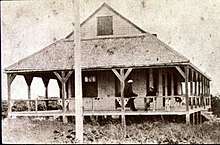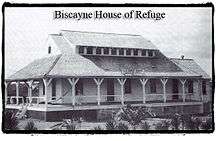Houses of Refuge in Florida
The Houses of Refuge in Florida were a series of stations operated by the United States Life-Saving Service along the coast of Florida to rescue and shelter ship-wrecked sailors. Five houses were constructed on the east coast in 1876, with five more added in 1885. There were also two life-saving stations built, one just south of the Jupiter Inlet, the other on the Gulf coast on Santa Rosa Island near Pensacola, Florida. A house of refuge was planned for the Marquesas Keys, but was never put into commission. The houses were manned by civilian contractors who lived in the houses with their families. Most of these houses remained in service as life-saving stations until 1915 or later. Some of the locations became United States Coast Guard stations after the Life Saving Service was merged into the Coast Guard in 1915.


The houses were built of Florida pine, using 8x8 heartwood timbers for the foundation and frame. They were intended to withstand hurricanes, although at least two of them were destroyed by hurricanes in later years. The main floor was divided into four rooms, and a wide porch surrounded the building. The North room was the kitchen. Next was the dining room, living room and at the South end was the bedroom. All the stations were alike and all the Keepers used the rooms in the same manner. The station keeper's family occupied the main floor. The attic was a dormitory for ship-wrecked sailors, equipped with 20 cots with bedding and dried and salted provisions to feed 20 men for 10 days. While the houses were equipped with lifesaving equipment, they were intended as passive refuges for sailors who made it to land, and not as active lifesaving stations.[1][2][3]
Locations
The houses of refuge in Florida were:
- Smith's Creek, 20 miles south of Matanzas Inlet, 29°26′10″N 81°06′25″W 1886 - 1915, Coast Guard station 1915 - 1918, 1924 - ?[4]
- Mosquito Lagoon, east of the Mosquito Lagoon, 28°51′30″N 80°46′20″W 1886 - 1915, Coast Guard Station 203 1915 - ?[5]
- Chester Shoal, 11 miles north of Cape Canaveral, 28°36′40″N 80°35′50″W 1886 - 1915, Coast Guard Station 204 1915 - ?[6]
- Cape Malabar, 30 miles south of Cape Canaveral, 28°03′10″N 80°32′45″W 1886 - 1891[7][2]
- Indian River or Bethel Creek, sixteen miles north of the Indian River Inlet (now known as the Fort Pierce Inlet), 27°40′00″N 80°21′20″W 1876 - 1885[8]
- Indian River Inlet, on the south side of the Indian River Inlet (inlet closed in 1890s, the station was approximately 2.2 miles north of today's Fort Pierce Inlet at Peppers Park, St. Lucie County), 27°29′45″N 80°17′50″W 1885 - 1915, Coast Guard Station 206 1915 - ?[9]
- Gilbert's Bar or Saint Lucie Rocks, two miles north of what is now the St. Lucie Inlet, near Stuart, Florida, 27°12′00″N 80°09′50″W 1896 -1915, Coast Guard Station 207 1915 - 1940, United States Navy beach patrol station 1940 - 1945[3]
- Jupiter Inlet, near the Jupiter Inlet Lighthouse. This was a life-saving station, rather than a house of refuge. A keeper was present year-round, with crew of six "surfmen" present during the winter.26°55′40″N 80°04′00″W 1886 - 1896[10][11]
- Orange Grove,26°27′30″N 80°03′20″W in what is now Delray Beach, Florida 1876 -1896[12][2]
- New River or Fort Lauderdale, in what is now Fort Lauderdale, Florida, 26°08′00″N 80°06′00″W 1876 - 1915, site of Coast Guard Station 6, 1915 – present, building destroyed by hurricane in 1930[13][2]
- Biscayne, at what is now 72nd Street on Miami Beach, Florida, 25°54′10″N 80°08′00″W 1876 - 1915, Coast Guard Station 209 1915 - 1926. Damaged beyond repair by the 1926 Miami hurricane.[14][2]
- Santa Rosa, on Santa Rosa Island close to Fort Pickens and the Pensacola Light. This was a life-saving station, rather than a house of refuge. 30°19′00″N 87°15′30″W 1885 - 1915, Coast Guard Station 212 1915 - 1986. Ranger station in Gulf Islands National Seashore as of 2002. Building destroyed by hurricane 1906, rebuilt 1907.[15][16]
The Gilbert's Bar House of Refuge is the only original house of refuge still standing in Florida, and is now a museum, operated by the Historical Society of Martin County. It is open to visitors and has various re-enactments and history programs year-round. The 1907 replacement building at the Santa Rosa Life-Saving Station still is standing.[17][16]
References
- Charles W. Pierce (1970). Pioneer Life in Southeast Florida. University of Miami Press. p. 264. ISBN 0-87024-163-X.
- "Houses of Refuge". Palm Beach County Historical Society. Retrieved 8 January 2012.
- "Gilbert's Bar House of Refuge" (PDF). U.S. Coast Guard History Program. Archived from the original (PDF) on May 1, 2017. Retrieved April 1, 2019.
- "Station Smith's Creek House of Refuge" (PDF). U.S. Coast Guard History Program. Archived from the original (PDF) on May 1, 2017. Retrieved April 1, 2019.
- "Mosquito Lagoon House of Refuge" (PDF). U.S. Coast Guard History Program. Archived from the original (PDF) on May 1, 2017. Retrieved April 1, 2019.
- "Chester Shoal House of Refuge" (PDF). U.S. Coast Guard History Program. Archived from the original (PDF) on May 1, 2017. Retrieved April 1, 2019.
- "Cape Malabar House of Refuge" (PDF). U.S. Coast Guard History Program. Archived from the original (PDF) on May 1, 2017. Retrieved April 1, 2019.
- "Indian River House of Refuge" (PDF). U.S. Coast Guard History Program. Archived from the original (PDF) on May 1, 2017. Retrieved April 1, 2019.
- "Indian River Inlet House of Refuge" (PDF). U.S. Coast Guard History Program. Archived from the original (PDF) on May 1, 2017. Retrieved April 1, 2019.
- "Station Jupiter Inlet Florida" (PDF). U.S. Coast Guard History Program. Archived from the original (PDF) on May 1, 2017. Retrieved April 1, 2019.
- "Jupiter Inlet Lifesaving Station". Historical Society of Palm Beach County. Retrieved 8 January 2012.
- "Orange Grove House of Refuge" (PDF). U.S. Coast Guard History Program. Archived from the original (PDF) on May 1, 2017. Retrieved April 1, 2019.
- "Fort Lauderdale House of Refuge" (PDF). U.S. Coast Guard History Program. Archived from the original (PDF) on May 1, 2017. Retrieved April 1, 2019.
- "Biscayne Bay House of Refuge" (PDF). U.S. Coast Guard History Program. Archived from the original (PDF) on May 1, 2017. Retrieved April 1, 2019.
- "Station Santa Rosa, Florida" (PDF). U.S. Coast Guard History Program. Archived from the original (PDF) on May 1, 2017. Retrieved April 1, 2019.
- "Santa Rosa Life-Saving Station". National Park Service. Archived from the original on July 5, 2012. Retrieved April 1, 2019.
- Gilbert's Bar House of Refuge Museum URL retrieved 23 March 2010
- Noble, Dennis L. "A Legacy: The United States Life-Saving Service" (PDF). U.S. Coast Guard History. Archived from the original (PDF) on May 17, 2017. Retrieved April 1, 2019.